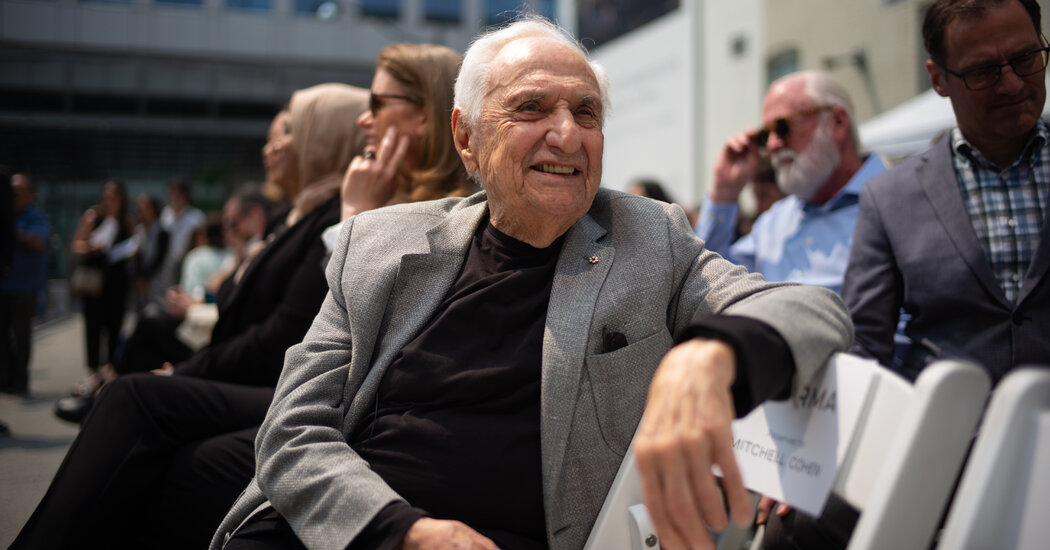Frank Gehry, the architect whose free-form Guggenheim Museum in Bilbao, Spain, redefined architecture and set off a surge in museum construction in the late 1990s, was recently back in Toronto, celebrating the beginning of a new project.
Born and raised in Toronto, Mr. Gehry has had only one work in Canada, his highly regarded renovation of the Art Gallery of Ontario, which opened in 2008 in the neighborhood where he grew up.
At 94, he is famously uninterested in retiring, and he came to Toronto last month to witness what he intends to be another masterpiece in Canada: two condo towers that will be his tallest project to date. One tower will be 84 stories high; the other, 74.
The project, known as Forma, will sit near Roy Thomson Hall, the current home of the Toronto Symphony Orchestra, on streets Mr. Gehry roamed in his youth, when the area was dominated by railway lines and warehouses.
It began as a collaboration between Mr. Gehry and Da Mirvish, the theater owner who Mr. Gehry knew from Mr. Mirvish’s days as a private art gallery owner. The original plan, unveiled a decade ago, was for three towers of more than 80 stories each, but was scaled back after backlash from the public and from some politicians. The final design preserves, rather than knocks down, the Princess of Wales Theatre and retains two of the four warehouses that would have been demolished in the first plan. Mr. Mirvish also sold the project to a consortium of developers.
After Mr. Gehry posed for many photos of the groundbreaking, I met with him in an office being used by the developers. Our conversation has been edited for length and clarity.
Do you still feel any connection to the streets around here?
I delivered telephone books on King Street when I was a kid; I pulled a little wagon. My grandfather’s hardware store was on Fleet Street West. And I used to go from 15 Beverley Street, where my grandma lived, to downtown to movies and stuff. So this neighborhood was all part of my early life.
So I have some feelings about the neighborhood, but not about the way it turned out.
How did your old neighborhood turn out?
A lot of it’s turned out to be the same old, like everywhere else. They build a tower and there’s not really much talk of heritage or relationship; it’s just Clunk! And it’s up.
The buildings in most cities in the world are pretty poor. I’m not just blaming Canada.
Has reshaping your childhood neighborhood been a particularly difficult project?
Unbelievable, kind of, that we’re doing this. It’s come after a lot of talk, a lot of work, a long time. But these things happen over time.
The city bureaucracy, the planning department, they were always supportive from day one. But they had a lot of comments, they wanted this and that. I accommodated them because they knew the city better than I did.
A lot of work has gone into it. It’s like a painting. So the glass is offset in places to take the light a certain way and separate that surface from the rest of the building. A lot of care has gone into organizing that visually. It’ll become apparent over the years. You’ll see it and you’ll say: Oh, that’s what he was doing.
After two projects in your old neighborhood, is there anything else you would like to take on there?
I grew up with classical music here at Massey Hall, when Sir Ernest MacMillan was the conductor. He used to ride a bicycle through Grange Park and I used to go through that park to Bloor Collegiate. He stopped one day and started talking to me. I said, “Well, I was at your concert last night,” which shook him up.
Unfortunately, Roy Thomson Hall acoustics aren’t the greatest. But I’m still very much into classical music and I would love to help fix it. Nobody’s asked me, but I’m ready to do it.
Jim Robbins reports on how Teck Resources, which is based in Vancouver, is at odds with regulators, First Nations and scientists in the United States over whether levels of selenium released from one of its mines in British Columbia have become a hazard to aquatic life across the international border.
A small lake in a conservation area on the Niagara Peninsula in Ontario has been selected to represent the Anthropocene, a proposed, and challenged, new chapter in geologic time.
A map made with annotated sonar images helps indicate how close the Titan submersible was to the deepwater wreck of the Titanic when it imploded, killing all five people inside.
Norman Mayersohn’s guide to summer destination car shows includes the Cobble Beach Concours d’Elegance near Owen Sound, Ontario. This year, it is focusing on Porsche’s 75th anniversary and Buick’s 120th.
“Black Ice,” a documentary by Hubert Davis about the racism Canadian hockey players of color endured at the hands of other players, coaches and fans, is a New York Times Critic’s Pick. Mr. Davis, writes Nicolas Rapold, “zeros in on how hockey has been a vital part of his country’s identity, and what it has felt like for Canadian players of color who love the game to be told, from very young ages, that they do not belong.”
In real estate, Tim McKeough describes how Stephan Weishaupt, a designer from Toronto, restored a tiny, dilapidated caretaker’s cabin in a rural area northwest of the city. A slide show documents the stylish result.
A native of Windsor, Ontario, Ian Austen was educated in Toronto, lives in Ottawa and has reported about Canada for The New York Times for two decades. Follow him on Twitter at @ianrausten.
How are we doing?We’re eager to have your thoughts about this newsletter and events in Canada in general. Please send them to [email protected].
Like this email?Forward it to your friends, and let them know they can sign up here.



